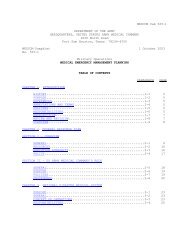(MCD) Guidelines
(MCD) Guidelines
(MCD) Guidelines
You also want an ePaper? Increase the reach of your titles
YUMPU automatically turns print PDFs into web optimized ePapers that Google loves.
<strong>Guidelines</strong> for Military Mass Casualty Decontamination Operations<br />
During a Domestic HAZMAT/Weapon of Mass Destruction Incident<br />
guidance established by Incident Command. One example would be using fire<br />
service pike poles or the water spray of a handline to hold people at bay.<br />
The media may also attempt to access the area, seeking to report information.<br />
Establish an area close enough to the site to meet the media’s needs for information<br />
but far enough away to keep them safe and from interfering with operations. Media<br />
personnel should be able to operate their equipment self-sufficiently. Power, lighting,<br />
sound, and other such equipment are not the responsibility of the responding<br />
agencies. The Public Information Officer should regularly report to this location to<br />
provide situational updates. This action can help place the responding agencies and<br />
the circumstances around the response in a more positive light.<br />
8.1.7. Casualty Collection Point<br />
INTENT: Begin to evacuate casualties from the hot zone in an organized and<br />
systematic manner.<br />
Taking control of the situation as soon as possible after<br />
arriving on the scene is a high priority for responders.<br />
First, separate those who can walk from those who<br />
cannot to begin triage, decontamination, and treatment<br />
prioritization.<br />
A public address system on most emergency vehicles is<br />
sufficient to direct those who can walk to go to a location<br />
away from the immediate release. An example statement<br />
includes, “If you can walk, go stand by the light pole, so<br />
the fire department can wash you off.” Among these<br />
casualties, separate those who are displaying symptoms<br />
and those who are not. Decontamination can then occur<br />
based on the priority system established by the Incident<br />
Commander. 15<br />
<strong>MCD</strong> Principles for<br />
Casualty Collection<br />
DHS UTL Tasks<br />
• ResB2b 6.1 and 6.2<br />
• ResC1a 6.1, 6.2, 6.2.1,<br />
6.2.2, 6.2.3, and 6.3<br />
• Res.C4a 4.3.1 and 4.3.2<br />
USACBRNS Tasks<br />
• 03-2-5124 Step 6b, 7a,<br />
and 7b<br />
• 03-2-6591 Step 9f<br />
• 03-2-6593 Steps 1b, 1d,<br />
1e, 2c, and 3b<br />
• 03-3-5128 Step 5b<br />
The initial triage, sometimes called decontamination triage, separates the<br />
ambulatory casualties from the nonambulatory casualties who cannot walk<br />
unassisted. From the nonambulatory casualties, find those who can follow simple<br />
directions from those who cannot. 2 Use a statement such as, “If you cannot walk<br />
and can hear my voice, raise a hand.”<br />
Because not all casualties will be able to walk, operational priorities may change<br />
based on the number of these casualties. Nonambulatory casualties require<br />
coordinated transport by litter through the decontamination processes. This<br />
demands a large number of personnel and resources.<br />
To control the casualty collection point, use engineer tape, “caution” tape, or existing<br />
obstacles to maintain entry-and-exit routes. This ensures casualties do not bypass<br />
38 Original



